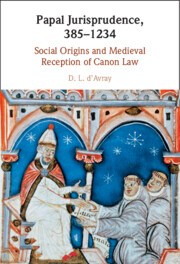Book contents
- Papal Jurisprudence, 385–1234
- Papal Jurisprudence, 385–1234
- Copyright page
- Dedication
- Contents
- Acknowledgements
- Abbreviations
- Sigla
- Introduction
- 1 Transformations and Long-Term Explanations
- 2 The Christian Roman Empire, c. 400
- 3 c. 400: Practical Complexities and Uncertainties
- 4 c. 400: Uncertainty about Grace
- 5 Papal Rulings and Ritual
- 6 Hierarchies
- 7 Clerical Status and Monks
- 8 Returning Heretics
- 9 Pelagianism and the Papacy
- 10 Leo I
- 11 Post-Imperial Syntheses
- 12 Early Papal Laws in the Barbarian West
- 13 Carolingian Culture and Its Legacy
- 14 1050–1150
- 15 Theology and Law
- 16 c. 400 and c. 1200: Complexity, Conversion, and Bigamia
- 17 Clerics in Minor Orders
- 18 Choosing Bishops
- Overall Conclusions
- Book part
- Select Bibliography
- Index
11 - Post-Imperial Syntheses
Published online by Cambridge University Press: 10 March 2022
- Papal Jurisprudence, 385–1234
- Papal Jurisprudence, 385–1234
- Copyright page
- Dedication
- Contents
- Acknowledgements
- Abbreviations
- Sigla
- Introduction
- 1 Transformations and Long-Term Explanations
- 2 The Christian Roman Empire, c. 400
- 3 c. 400: Practical Complexities and Uncertainties
- 4 c. 400: Uncertainty about Grace
- 5 Papal Rulings and Ritual
- 6 Hierarchies
- 7 Clerical Status and Monks
- 8 Returning Heretics
- 9 Pelagianism and the Papacy
- 10 Leo I
- 11 Post-Imperial Syntheses
- 12 Early Papal Laws in the Barbarian West
- 13 Carolingian Culture and Its Legacy
- 14 1050–1150
- 15 Theology and Law
- 16 c. 400 and c. 1200: Complexity, Conversion, and Bigamia
- 17 Clerics in Minor Orders
- 18 Choosing Bishops
- Overall Conclusions
- Book part
- Select Bibliography
- Index
Summary
In the fifth century bishops had brought problems to the apostolic see, which replied by laying down what was lawful and unlawful (leaving the bishops to do what they wanted with these responses). Shortly after the end of the empire in the West, the first decretal age comes to an end and a new phase begins: one of synthesis and compilation. This meant deciding what to leave out and what to include. Two collections, the Frisingensis prima and the Quesnelliana, include debate on the humanity and divinity of Christ, alongside the papal responses. The Dionysiana, however, leaves out these themes, which are in any case absent from the decretals of Siricius and Innocent I. Christological themes are absent also from letters of Leo I selected by Dionysius and from the ‘hold-all’ decretal Necessaria rerum dispositione of Gelasius I, which draws together in a quasi-synthesis the principal issues addressed in the first century of papal jurisprudence. Gelasius’s summative decretal and the Dionysiana anticipate the boundary that would separate canon law from what would be called theology, while the Frisingensis prima and Quesnelliana anticipate collections which recognize no such boundary.
Keywords
- Type
- Chapter
- Information
- Papal Jurisprudence, 385–1234Social Origins and Medieval Reception of Canon Law, pp. 120 - 133Publisher: Cambridge University PressPrint publication year: 2022

